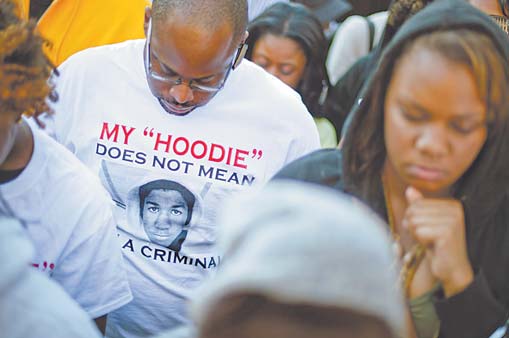Fla. teen’s case turns into brand, trademark

Andre Parker of Atlanta wears a T-shirt in memory of Trayvon Martin, the unarmed 17-year-old who was killed by a Florida neighborhood-watch captain while returning from a convenience store, during a rally outside the Georgia Capitol in Atlanta. The Martin case quickly is becoming an Internet-fueled brand.
Associated Press
MIAMI
From the T-shirt and hoodie sales to trademarking slogans such as “Justice for Trayvon” to the pass-the-hat rallies that bring in thousands, the case of an unarmed black teenager killed by a neighborhood- watch volunteer quickly is turning into an Internet-fueled brand.
Websites are hawking key chains bearing Trayvon Martin’s likeness. His parents have bought two trademarks, saying they hope to raise money to help other families struck by tragedy. Trayvon clothes, bumper stickers, buttons and posters are up for grabs on eBay.
Vendors selling Martin T-shirts and hoodies have become fixtures at rallies in Sanford, the central Florida town where Martin was shot last month. At one Sanford rally this week, a man had a variety of T-shirts laid out on the ground as marchers went by, yelling out, “I’ve got every size!”
The Martin shooting by neighborhood-watch volunteer George Zimmerman, who says he shot the 17-year-old Miami teen in self-defense, has inflamed racial tensions across the country, brought out thousands for rallies, prompted a civil-rights probe and a personal reference to the case by President Barack Obama.
A phenomenon on that scale is bound to be commercialized, said Donna Hoffman, a marketing professor at the University of California-Riverside.
“People can start to wear their feelings and emotions. It makes sense, even if there’s a profit motive,” Hoffman said. “There’s a legitimate interest in sharing the pain, and these products do that.”
Van Johnson, who designs T-shirts and other apparel in Charlotte, N.C., said he initially wanted to come up with something for his 12-year-old son to show solidarity with Martin’s supporters. He produced a color drawing based on a photograph of Martin wearing a hoodie, which the teenager was wearing on the night he was killed.
“I really don’t expect to make more than $200 at the most,” Johnson said. “I’m happy some people bought my products; that way, a few people will have a very nice design on their shirt or hoodie to show their support.”
Hoffman said it’s |difficult to gauge how the Trayvon sales might stack up against those from similar cases, such as the 1992 Los Angeles riots after the Rodney King beating, because those were before the explosion of Internet marketing.
“Anyone can do it with any image,” she said.
 43
43
